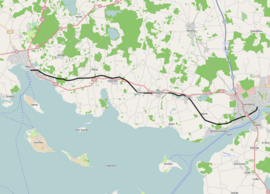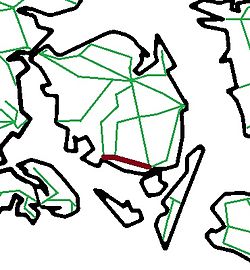Svendborg – Faaborg railway line
| Svendborg – Faaborg | |||||||||||||||||||||||||||||||||||||||||||||||||||||||||||||||||||||||||||||||||||||
|---|---|---|---|---|---|---|---|---|---|---|---|---|---|---|---|---|---|---|---|---|---|---|---|---|---|---|---|---|---|---|---|---|---|---|---|---|---|---|---|---|---|---|---|---|---|---|---|---|---|---|---|---|---|---|---|---|---|---|---|---|---|---|---|---|---|---|---|---|---|---|---|---|---|---|---|---|---|---|---|---|---|---|---|---|---|
|
Svendborg – Faaborg railway line
| |||||||||||||||||||||||||||||||||||||||||||||||||||||||||||||||||||||||||||||||||||||
|
Location of the route on Funen
| |||||||||||||||||||||||||||||||||||||||||||||||||||||||||||||||||||||||||||||||||||||
| Route length: | 26.4 km | ||||||||||||||||||||||||||||||||||||||||||||||||||||||||||||||||||||||||||||||||||||
| Gauge : | 1435 mm ( standard gauge ) | ||||||||||||||||||||||||||||||||||||||||||||||||||||||||||||||||||||||||||||||||||||
| Operating points and routes | |||||||||||||||||||||||||||||||||||||||||||||||||||||||||||||||||||||||||||||||||||||
|
|||||||||||||||||||||||||||||||||||||||||||||||||||||||||||||||||||||||||||||||||||||
The Svendborg – Faaborg railway was a railway line on the Danish island of Funen . It runs from Faaborg to Svendborg and was built as a private railway and leased to Sydfyenske Jernbaner (SFJ). On April 1, 1949, the line was taken over by Danske Statsbaner (DSB).
history
After the construction of the Svendborg – Nyborg railway in 1897, the construction of a line from Svendborg to Faaborg quickly came on the agenda. In the spring of 1901 Johannes Stensballe , who at the time was in charge of the construction of the waterworks in Svendborg as an engineer, was given the task of preparing a project for a railway from Svendborg to Faaborg.
The project differed significantly from the track construction carried out later. The line led over the market square and over the Møllergade to the track of the Svendborg – Nyborg Banen east of the Havnegade and then to the existing train station. In terms of the curve radii and the gradient, the project was technically not fully developed, and given the conditions in Svendborg, the route would not have been able to cope with traffic.
Despite the estimated low construction costs, interest in the railway line among the rural communities was not very high. It was not until 1904 that a planning committee was founded with the veterinarian Rasmus Rasmussen Skov († 1908) as chairman. In 1905 a new proposal for the route was prepared and in 1906 a request was submitted to the Jernbane Commission according to which the state should pay half of the land costs. As a result, the current route was included in the Railway Act of May 27, 1908 .
Faaborg – Svendborg Jernbaneselskab
In the meantime there was enough interest in the formation of a stock corporation. However, when the chairman of the Skov committee died in 1908, the project fell asleep again. It was not until 1912 that the planning was continued under the new chairman, Count Ahlefeldt-Laurvig-Lehn from Hvidkilde . New perspectives were developed and the final route was determined. The draft for the construction of the line had been worked out by Stensballe, who was now a line engineer from Sydfyenske Jernbaner (SFJ). The application was made on April 23, 1912.
On June 15, 1914, the Faaborg – Svendborg Jernbaneselskab (also Svendborg – Fåborg Jernbaneselskab (SFB) ) received the license to operate. After the construction, the operation took place from the opening by SFJ. The contract of August 20, 1914 with SFJ, approved by the Ministry of Public Works on September 29, 1914, provided that no fewer than four passenger trains were to run in each direction per day, as well as the vehicles available on the railway in other areas of SFJ can be used. The rent for the route was three percent.
Only the track between Svendborg and Katterød was built. Between Katterød and Faaborg, the SFB used the existing track on the rings – Faaborg railway line since 1882 . In the course of this section, land was procured and the construction of a second track was planned. However, the construction of the second track was not carried out.
However, a new branch station was built in Katterød, where previously there was only a station keeper's house with a ticket sales point.
The line was opened on November 25, 1916 and consisted of the sections Svendborg – Katterød with a length of 22.1 km with gravel substructure and Katterød – Faaborg with a length of 4.3 km with gravel substructure, making a total of 26.4 km. The cost of construction amounted to 1,397,000 crowns .
Buildings
All five intermediate stations (Egense, Ollerup, Vester Skerninge, Ulbølle and Vester Åby) had crossing tracks and loading tracks with side ramps and head ramps, as well as some private warehouses. The three stops had wooden shelters with a canopy mounted on wooden pillars, Åkilde and Nakkebølle also had a crossing track.
Takeover by Danske Statsbaner
On April 1, 1949, the line was taken over by Danske Statsbaner (DSB). The company ceased operations on May 22, 1954.
Preserved buildings and parts of the route
All five station buildings are still preserved today and are in use. There is a bus station in front of the train station in Faaborg. Three kilometers of the embankment have been preserved and are accessible. half of this stretch is west of Svendborg, where Øhavsstien follows the dam for 1½ km.
literature
- Lars Viinholt-Nielsen: Svendborg-Fåborg Banen . SFJ-bøger, 1995, ISBN 87-984810-1-0 .
- Niels Jensen: Fynske jernbaner . København 1976, ISBN 87-11-03736-9 , p. 97-101 .
Web links
- Erik V. Pedersen: Svendborg - Faaborg banen. In: EPP. Retrieved June 5, 2016 .
- Drift bestyrist Johannes Stensballe fortæller banens historie. fynhistorie.dk, accessed on June 5, 2016 .
- Syd Fyenske Veteranjernbane: Fynske jernbaner, SFB. Retrieved June 5, 2016 (Danish).
- Sydfynske Jernbane (Svendborgbanen). (History and vehicle inventory). jernbanen.dk, accessed June 5, 2016 (Danish).


